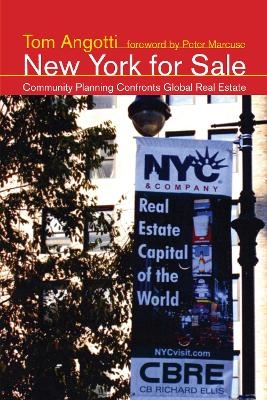
New York for Sale
Community Planning Confronts Global Real Estate
Seiten
2011
MIT Press (Verlag)
978-0-262-51593-1 (ISBN)
MIT Press (Verlag)
978-0-262-51593-1 (ISBN)
- Titel ist leider vergriffen;
keine Neuauflage - Artikel merken
How community-based planning has challenged the powerful real estate industry in New York City.
Remarkably, grassroots-based community planning flourishes in New York City-the self-proclaimed "real estate capital of the world"-with at least seventy community plans for different neighborhoods throughout the city. Most of these were developed during fierce struggles against gentrification, displacement, and environmental hazards, and most got little or no support from government. In fact, community-based plans in New York far outnumber the land use plans produced by government agencies. In New York for Sale, Tom Angotti tells some of the stories of community planning in New York City: how activists moved beyond simple protests and began to formulate community plans to protect neighborhoods against urban renewal, real estate mega-projects, gentrification, and environmental hazards. Angotti, both observer of and longtime participant in New York community planning, focuses on the close relationships among community planning, political strategy, and control over land. After describing the political economy of New York City real estate, its close ties to global financial capital, and the roots of community planning in social movements and community organizing, Angotti turns to specifics. He tells of two pioneering plans forged in reaction to urban renewal plans (including the first community plan in the city, the 1961 Cooper Square Alternate Plan-a response to a Robert Moses urban renewal scheme); struggles for environmental justice, including battles over incinerators, sludge, and garbage; plans officially adopted by the city; and plans dominated by powerful real estate interests. Finally, Angotti proposes strategies for progressive, inclusive community planning not only for New York City but for anywhere that neighborhoods want to protect themselves and their land. New York for Sale teaches the empowering lesson that community plans can challenge market-driven development even in global cities with powerful real estate industries
Remarkably, grassroots-based community planning flourishes in New York City-the self-proclaimed "real estate capital of the world"-with at least seventy community plans for different neighborhoods throughout the city. Most of these were developed during fierce struggles against gentrification, displacement, and environmental hazards, and most got little or no support from government. In fact, community-based plans in New York far outnumber the land use plans produced by government agencies. In New York for Sale, Tom Angotti tells some of the stories of community planning in New York City: how activists moved beyond simple protests and began to formulate community plans to protect neighborhoods against urban renewal, real estate mega-projects, gentrification, and environmental hazards. Angotti, both observer of and longtime participant in New York community planning, focuses on the close relationships among community planning, political strategy, and control over land. After describing the political economy of New York City real estate, its close ties to global financial capital, and the roots of community planning in social movements and community organizing, Angotti turns to specifics. He tells of two pioneering plans forged in reaction to urban renewal plans (including the first community plan in the city, the 1961 Cooper Square Alternate Plan-a response to a Robert Moses urban renewal scheme); struggles for environmental justice, including battles over incinerators, sludge, and garbage; plans officially adopted by the city; and plans dominated by powerful real estate interests. Finally, Angotti proposes strategies for progressive, inclusive community planning not only for New York City but for anywhere that neighborhoods want to protect themselves and their land. New York for Sale teaches the empowering lesson that community plans can challenge market-driven development even in global cities with powerful real estate industries
Tom Angotti is Director of the Hunter College Center for Community Planning and Development and Professor of Urban Affairs and Planning at Hunter College, City University of New York. He is the author of Metropolis 2000: Planning, Poverty, and Politics, the coeditor of Progressive Planning Magazine, and a columnist for the online journal Gotham Gazette.
| Reihe/Serie | Urban and Industrial Environments |
|---|---|
| Vorwort | Peter Marcuse |
| Zusatzinfo | 17 figures; 17 Illustrations, unspecified |
| Verlagsort | Cambridge, Mass. |
| Sprache | englisch |
| Maße | 152 x 229 mm |
| Gewicht | 431 g |
| Themenwelt | Naturwissenschaften ► Geowissenschaften ► Geografie / Kartografie |
| Sozialwissenschaften ► Politik / Verwaltung ► Staat / Verwaltung | |
| Sozialwissenschaften ► Soziologie | |
| Wirtschaft ► Betriebswirtschaft / Management ► Rechnungswesen / Bilanzen | |
| Betriebswirtschaft / Management ► Spezielle Betriebswirtschaftslehre ► Immobilienwirtschaft | |
| ISBN-10 | 0-262-51593-8 / 0262515938 |
| ISBN-13 | 978-0-262-51593-1 / 9780262515931 |
| Zustand | Neuware |
| Haben Sie eine Frage zum Produkt? |
Mehr entdecken
aus dem Bereich
aus dem Bereich
Handbuch für Studium und Praxis
Buch | Hardcover (2023)
Vahlen (Verlag)
79,00 €
Erfolgsstrategien für den modernen Immobilienmarkt
Buch | Softcover (2024)
ForwardVerlag
18,00 €
warum Rene Benkos Immobilienimperium zusammenbrach und was dem …
Buch | Hardcover (2024)
FinanzBuch Verlag
22,00 €


